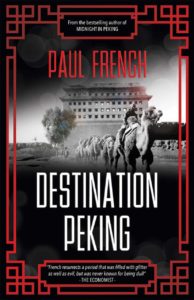Destination Peking by Paul French. Hong Kong: Blacksmith Books, 2021. Available from Blacksmith Books and Amazon.

I like China books and murder mysteries, so years ago I read Paul French’s Midnight in Peking—a book that fit the bill on both accounts. When French’s new book, Destination Peking came out earlier this year, it seemed time to try another of his forays into the lives of expatriates in early 20th century China, even if murder wasn’t involved.
Destination Peking and its companion book Destination Shanghai (2018) are each collections of 18 biographical essays about non-Chinese people who lived in those cities around or before the Japanese invasion of China. The individuals profiled in Destination Peking are an eclectic and generally lesser-known group that includes actors, artists, brigands, prostitutes, scholars (of a sort), writers, the wealthy, and diplomatic types.
As I read the book, I found myself wondering if the subjects of the essays were really the people highlighted. Or were the people simply anchors from which to explore the place, the time, or the lives of other people French wanted to include but couldn’t in just 18 essays.
The first essay, “The Rooftop of the Grand Hôtel de Pékin: Wallis Spencer’s Peking World & Those Who Went Up on the Roof (1924)” is far more about the hotel than Wallis Spencer. It even begins “It is fitting to start this collection with an essay about the Hôtel de Pékin” (p. 22). Wallis Spencer is the person highlighted but the “biography” is really the hotel’s not hers.
Wallis isn’t ignored. There are details about her arrival in Peking from Tientsen which took “a grueling thirty-eight hours to cover the barely seventy miles between the two northern Chinese cities thanks to a typhoid outbreak in Tientsin, marauding bandits and skirmishing warlords” (p. 25-26). And we learn why she was there and could afford to stay at the Grand Hôtel de Pékin—she was delivering official US government papers (p. 28). We also get glimpses of the life of young Wallis who would later become Wallis, Duchess of Windsor, the woman for whom Edward VIII gave up his throne (p.23-28). But the real story is the hotel and its famed rooftop bar and open-air dancing. French notes that undoubtedly all those he profiles in the book passed at one time or another through the doors of the Grand Hôtel de Pékin (pp.22-23).
The tale of young Denton Welch’s brief stay in Peking (he was there on holiday visiting relatives) provides the opportunity to describe a British Christmas in 1932. While there is a good account of his birth in Shanghai to British parents, his early years in Shanghai and subsequent schooling in a British boarding school, it seems that the main reason for including Welch is so the skating parties, elaborate dinners, and other social events of his Christmas holiday in Peking can be described in detail. My favorite detail was that “[a] tailor stitched an old moleskin rug inside Denton’s only overcoat to upgrade it from a Shanghai winter coat to a thicker Peking winter coat” (p. 118). Now that’s resourceful.
The time French covers is just before the Japanese invaded China, so his inclusion of Japanese American artist Isamu Noguchi gives us glimpse of the Japanese community in Peking and the cordial relations some had with Chinese residents. It was through a Japanese acquaintance that Noguchi met Chi Pai Shi, a renowned calligrapher. And through Chi he met other Chinese artists (p. 134).
The essay on a crime wave perpetuated on Peking by a band of international bandits includes a description of Peking at the time, which explains why Peking was ripe for such a spree of lawlessness. The robberies—and a murder or two—occurred as the Japanese were encroaching on the city. The ensuing chaos included a surge in refugees resulting in tensions with Peking residents, food and other shortages, and the isolation of the city from the rest of the country (p. 96-97). There was little capacity to rein in those who saw the chaos as an opportunity.
The essay I enjoyed the most was about the person rather than the place. “The Woman Who Created the Wartime Image of China in America: Martha Sawyers (1941)” tells the backstory of posters used by United China Relief to “raise the American public’s awareness of China’s resistance to Japan and to collect funds to directly aid civilians (p. 324). There is far more in this essay about Martha Sawyers, her travels, her art, and the impact her art had on American perceptions of Asians than it does about her very brief time in Peking. She had no more than arrived when she and her husband had to flee the Japanese occupation. But during her travels through Asia, she developed her “trademark style of portraiture” and respect for the people she painted. (pp. 330-331). There were no stereotypical caricatures in her work.
And I appreciated the images, including reproductions of Sawyer’s posters and the many photographs of the people and places mentioned in the essays. Destination Peking is not a just a good read, it’s a good look.
The book does not shy away from the darker aspects of the expatriate community of Peking. There were some details I would have just as soon not had included. But the treasure trove of wide-ranging observations and information about the Peking of that time and its expat sojourners make it well worthwhile for understanding more about the Peking of that time.
(And if the spellings bothered you in this post—don’t read the book. It will drive you crazy. )
Our thanks to Blacksmith Books for supplying a copy of Destination Peking for this review.
Image credit: Sanshichiro Yamamoto – Peking (1906), Public Domain.

Narci Herr
Narci Herr and her husband, Glenn, lived for just over 30 years in Hong Kong. They were first involved in working with the church in Hong Kong and then for the last 20 years of their time in Asia they served workers living in China. During that time Glenn traveled extensively throughout China and Narci …View Full Bio
Are you enjoying a cup of good coffee or fragrant tea while reading the latest ChinaSource post? Consider donating the cost of that “cuppa” to support our content so we can continue to serve you with the latest on Christianity in China.